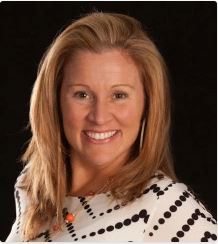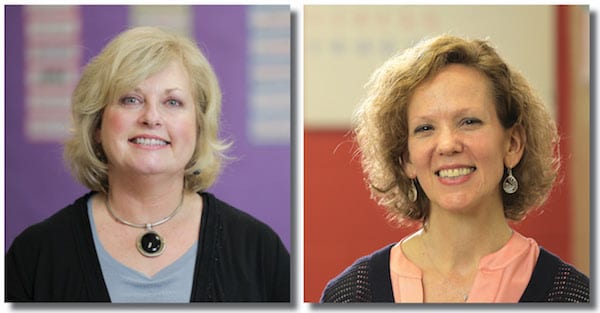Fraction Number Talks: An Interview with Sherry Parrish & Ann Dominick
by February 24th, 2017
 All Blog Posts
All Blog Posts
We’re thrilled to welcome Kristin Gray, K-5 Math Specialist and author of Math Minds, to the blog today. She recently interviewed Sherry Parrish and Ann Dominick, authors of Number Talks: Fractions, Decimals, & Percentages, about their processes and experience as math educators. Both authors share how their careers in math education inspired their work with number talks, and how students can benefit from these dynamic strategies and methods.
Many of my favorite books in math education are inspired by classroom experiences. How did your classroom experiences inspire all of your work with Number Talks?
We both started our teaching careers teaching the way we had been taught. We gave our students step-by-step procedures, and they practiced them over and over. Once we began studying with Dr. Constance Kamii, a professor who had worked with Jean Piaget, however, our thinking changed. Connie challenged our beliefs about teaching and learning through Piaget’s work centered on the idea that there are actually three different types of knowledge. (We discuss this more in Number Talks: Fractions, Decimals, and Percentages.) Knowledge that has its ultimate source in other people, and changes from society to society, like the names for things or how something is written, is something we have to tell students. It’s called social knowledge. Things like, “This is called the distributive property,” or “You can write the multiplication sign as an ‘x’ but you can also write it as a dot,” are social conventions and can change from society to society or over time.
We ask instead of tell, however, when we are dealing with logico-mathematical knowledge. Logico-mathematical knowledge has its ultimate source in the mental relationships that students make for themselves. There are different ways to solve the problem 16 x ¾ because there is logic involved. When we ask students, “How could you solve this? How do you know?” it’s because we know we are dealing with logico-mathematical knowledge and that the source of this knowledge is students’ own mental relationships.
Understanding the difference between different types of knowledge changed our classroom practice from giving students procedures to asking students to create or “invent” strategies based upon mental relationships they were making. When our teaching practices changed, it was the difference we saw in our students’ thinking, and also in how much they enjoyed math, that inspired the work we have done with Number Talks.
When you designed the Number Talks for your book, did you field test all of the problems with students or only select ones? How did you decide on the ones to use with students and ones you knew were not necessary to field test because they would elicit similar ideas?
The framework and structure for many of the problems in our book comes from our years of experiences doing Number Talks as classroom teachers. Other problems were developed and tested when serving as math coaches, university professors, and researchers through the Greater Birmingham Mathematics Partnership. Each of these roles offered opportunities to test and evaluate number talk strings with classroom teachers, their students, as well as our pre-service and graduate students. Through these different lenses, we noticed which types of problems encouraged specific strategies. Finally, we asked teachers in different areas of the country to field test various number talk strings with their students, videotape the Number Talks, and provide feedback. This was invaluable as we made final decisions.
I love using Number Talks in my classroom and have a lot of fun playing around with designing my own based on students’ needs. I would love to hear more about your design process when thinking through the series of problems in a string. How do you think about the purpose of each problem and the progression in which they are listed?
We keep three areas in mind when designing a Number Talk string: 1) the purpose of the string, 2) accessibility for a diverse group of students, and 3) sequencing the problems to help students look for and make numerical relationships.
For example, when designing a multiplication string focused on the partial products strategy, we choose smaller multiplication problems that can be used to decompose one of the factors in the final problem. This scaffolding offers multiple ways for students to access the problems, participate, and be successful during the Number Talk. Consider the sequence in the following Number Talk string.
1/2 x 4/5
1/4 x 4/5
3/4 x 4/5
Beginning with 1/2 of something instead of 1/4 offers an accessible starting point for most students. Asking, “How can you use what we already know to help you with the next problem?” encourages students to think about the relationship between 1/2 and 1/4. The final problem in this string can be solved from using any of the previous problems. We might anticipate the following ideas.
| 3/4 x 4/5
=(1/2 + 1/4) x 4/5 =(1/2 x 4/5) + (1/4 x 4/5) =2/5 + 1/5 =3/5 |
3/4 x 4/5
=(1/4 + 1/4 + 1/4) x 4/5 =(1/4 x 4/5)+(1/4 x 4/5)+ (1/4 x 4/5) = 1/5 + 1/5 + 1/5 = 3/5 |
| 3/4 x 4/5
= (3 x 1/4) x 4/5 = 3 x (1/4 x 4/5) =3 x 1/5 = 3/5
|
3/4 x 4/5
= (3/4 x 2) x (4/5 x 1/2) = 1 ½ x 2/5 = (1 ½ x 2) x (2/5 x 1/2) = 3 x 1/5 = 3/5 |
The purpose of the Number Talk string is not to “guarantee” all students will approach the problem(s) using the same relationships. We realize students will make and use other relationships besides the ones we are trying to highlight, such as Doubling and Halving. That’s the beauty of using Number Talks – there are multiple ways to reach a solution.
My friend Michael Pershan and I talk about Number Talks a lot, so I reached out to him when I knew I had the opportunity to interview you. He brought up two question(s) I think many teachers, including myself, find challenging when using Number Talks:
a) How do you think of the movement from whole-talk to individual work?
We have found that this is typically a seamless progression when students are the ones making relationships and sharing their thinking during the Number Talk. When the ideas come from students, they “own” them and are able to use them beyond the Number Talk. There are two areas to consider when transitioning from a whole group Number Talk to individual work.
First, are the strategies that have surfaced during the Number Talk based on students’ ideas? If the strategies originated from students, transitioning to working individually is typically comfortable. However, because many of us were never asked to “invent” our own procedures, we are often not confident students can do this and we resort to “teaching” alternative strategies. When this occurs, students try to remember what they were told to do instead of building on their own relationships.
Second, how we record a strategy serves as a model for students as they record their ideas. As students share their thinking during a Number Talk, it is important that we represent their strategies accurately using expressions and equations. This correct recording supports their individual work.
b) What do you see as bridging the strategy talk and individual thinking?
When the students are convinced that certain ideas will always work for a specific operation, let them help create a class anchor chart with a computation problem and all of the strategies that can be used to solve the problem. As new ideas arise, they can be added to the chart. This documentation of a collection of student ideas is an excellent support for students as they are working individually. It provides a reference to accurately represent ideas that have been tested and proven.
It is also helpful to check in with students’ understandings by using an exit ticket once every week or two. For example, if we have been working on dividing fractions during our Number Talk, we can pose a problem and ask the students to return to their desks and show two ways they might solve the problem. This is an easy way to gather formative data on understanding, strategies, and recording.
You now have two books on Number Talks that range from whole number operations to fractions and decimals. On a more personal note, I would love to know which Number Talks are your favorite to design and why?
Multiplication problems and strings are our favorite to design because of the elegance and sophistication of this operation and how various strategies seem to “unlock” such important mathematical ideas. Throughout the years we have seen such confusion around this operation from students who have only have access to the standard U.S. algorithm. When they realize they are capable of making relationships, building on things they know, and making meaning of multiplication, it is definitely a highlight!
 Sherry Parrish has spent more than 35 years in the field of education. Sherry holds a doctorate in Educational Leadership from Samford University and is a recipient of the Presidential Award for Excellence in Mathematics Teaching. As a former classroom educator and assistant professor, she advocates for the teaching and learning of mathematics through inquiry. She is the author of the award-winning Number Talks: Whole Number Computation, Grades K–5, and co-author of Number Talks: Fractions, Decimals, & Percentages, and currently works with teachers nationally and internationally in the area of mathematics. Connect with Sherry on Twitter: @numbertalks.
Sherry Parrish has spent more than 35 years in the field of education. Sherry holds a doctorate in Educational Leadership from Samford University and is a recipient of the Presidential Award for Excellence in Mathematics Teaching. As a former classroom educator and assistant professor, she advocates for the teaching and learning of mathematics through inquiry. She is the author of the award-winning Number Talks: Whole Number Computation, Grades K–5, and co-author of Number Talks: Fractions, Decimals, & Percentages, and currently works with teachers nationally and internationally in the area of mathematics. Connect with Sherry on Twitter: @numbertalks.
 Ann Dominick received her undergraduate degree in education from Auburn University, a Master’s in Education from the University of Alabama at Birmingham, a doctorate from Vanderbilt University, and a Certificate of Advanced Studies in Curriculum and Instruction at Harvard University. She was awarded the National Science Foundation’s Presidential Award for Excellence in Teaching Elementary Mathematics and is a former Alabama State Teacher of the Year. She is currently an Assistant Professor at the University of Alabama at Birmingham teaching mathematics and education courses and preparing undergraduates to be secondary mathematics and science teachers. Ann is the co-author of Number Talks: Fractions, Decimals, & Percentages. Connect with Ann on Twitter: @Dominick_Math.
Ann Dominick received her undergraduate degree in education from Auburn University, a Master’s in Education from the University of Alabama at Birmingham, a doctorate from Vanderbilt University, and a Certificate of Advanced Studies in Curriculum and Instruction at Harvard University. She was awarded the National Science Foundation’s Presidential Award for Excellence in Teaching Elementary Mathematics and is a former Alabama State Teacher of the Year. She is currently an Assistant Professor at the University of Alabama at Birmingham teaching mathematics and education courses and preparing undergraduates to be secondary mathematics and science teachers. Ann is the co-author of Number Talks: Fractions, Decimals, & Percentages. Connect with Ann on Twitter: @Dominick_Math.
 Kristin Gray is a K-5 Math Specialist at Richard A. Shields Elementary School in the Cape Henlopen School District in Lewes, Delaware. During her 21 years in education, she has taught 5th–8th grade math, as well as spent two years as a K-5 Math Specialist. She feels fortunate to be a curriculum writer for Illustrative Mathematics and Teaching Channel Laureate. As a teacher, colleague, presenter, and learner, Kristin continuously shares the value of curiosity around student thinking in her planning and instruction. She is a National Board Certified Teacher and 2014 Presidential Awardee for Excellence in Mathematics and Science Teaching. She is always excited to share her love of teaching at conferences such as NCTM, NCSM, and ISTE, as well as on her blog. Connect with Kristin on Twitter: @MathMinds.
Kristin Gray is a K-5 Math Specialist at Richard A. Shields Elementary School in the Cape Henlopen School District in Lewes, Delaware. During her 21 years in education, she has taught 5th–8th grade math, as well as spent two years as a K-5 Math Specialist. She feels fortunate to be a curriculum writer for Illustrative Mathematics and Teaching Channel Laureate. As a teacher, colleague, presenter, and learner, Kristin continuously shares the value of curiosity around student thinking in her planning and instruction. She is a National Board Certified Teacher and 2014 Presidential Awardee for Excellence in Mathematics and Science Teaching. She is always excited to share her love of teaching at conferences such as NCTM, NCSM, and ISTE, as well as on her blog. Connect with Kristin on Twitter: @MathMinds.


Comments